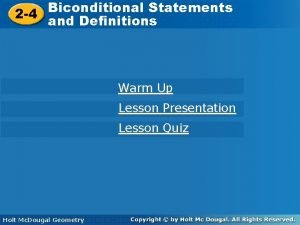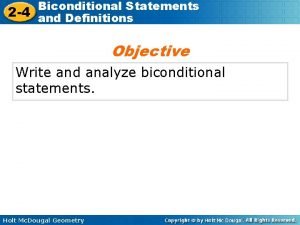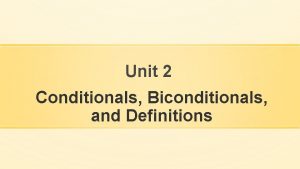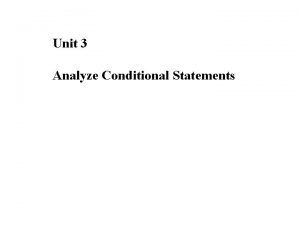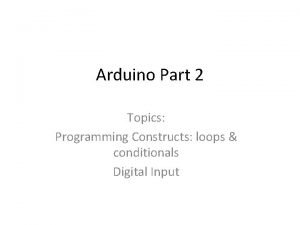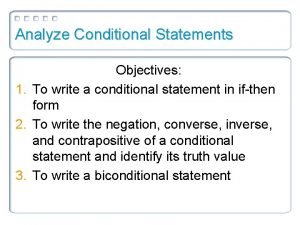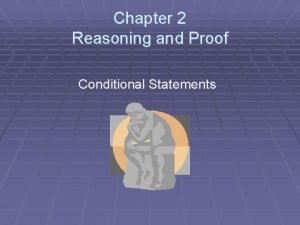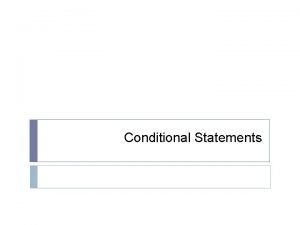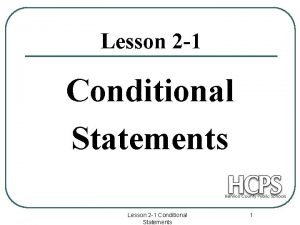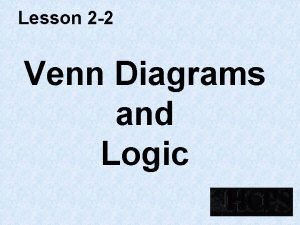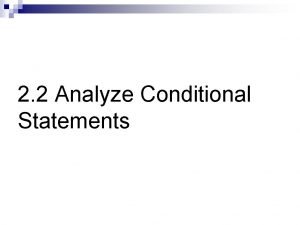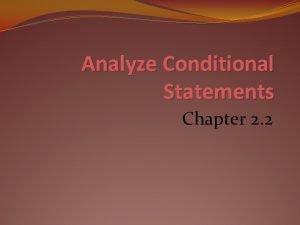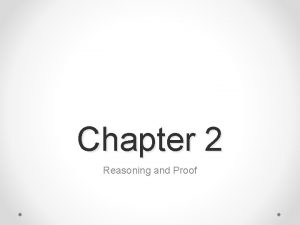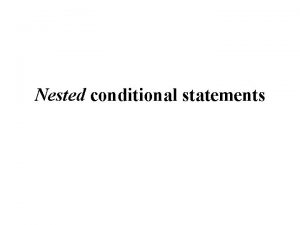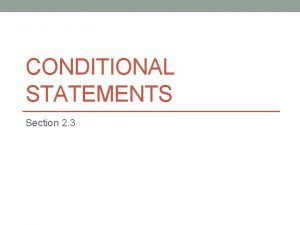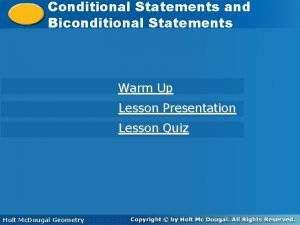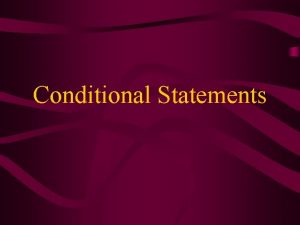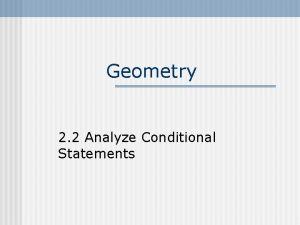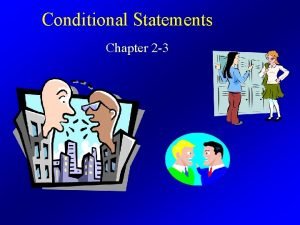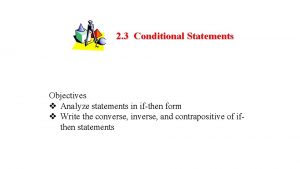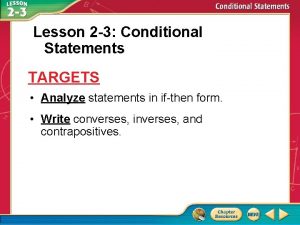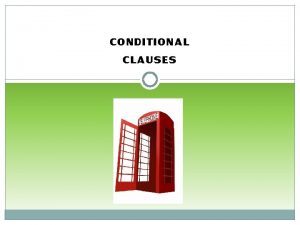2 2 Analyze Conditional Statements n Definitions conditional













- Slides: 13

2. 2 Analyze Conditional Statements

n. Definitions: conditional statement: a logical statement that has two parts, a hypothesis and a conclusion. if-then form: a conditional statement written where “if” contains the hypothesis and “then” contains the conclusion. Example: On Sundays, there is football on TV. “If it is Sunday, then there is football on TV. ” hypothesis conclusion

Example 1 n. Rewrite the conditional statement in if-then form. (a) All 90° angles are right angles. If an angle measures 90°, then it is a right angle. (b) When n = 9, n 2 = 81. If n = 9, then n 2 = 81. (c) Three points are collinear if there is a line containing them. If there is a line containing three points, then the three points are collinear.

n. Definitions: Negation: the opposite of the original statement Statement: The ball is red. Negation: The ball is not red. Statement: The cat is not black. Negation: The cat is black.

Related Conditionals: Converse: exchange the hypothesis and conclusion Inverse: negate both the hypothesis and conclusion Contrapositive: exchange both the hypothesis and conclusion, then negate them both.

Example 2 Rewrite the conditional statement in if-then form, then write the converse, inverse, and contra-positive. “Since m A = 99º it is an obtuse angle. ” If-Then: If m A = 99º, then A an obtuse angle. Converse: If A is an obtuse angle, then m A = 99º. Inverse: If m A ≠ 99º, then A is not obtuse. Contrapositive: If A is not obtuse, then m A ≠ 99º. Which of the above statements are true?

You try! Rewrite the conditional statement in if-then form, then write the converse, inverse, and contra-positive. “The supplementary angles add up to 180º” If-Then: If two angles are complementary, then they add up to 180º Converse: If two angles add up to 180º, then they are supplementary. Inverse: If two angles are not supplementary, then they do Contrapositive: not add up to 180º If two angles do not add up to 180º, then they are not supplementary.

*With any definition, both the conditional statement and its converse are true. m Perpendicular lines: If two lines intersect to form a right angle, then they are perpendicular lines. Or. . . If two lines are perpendicular, then they intersect to form a right angle. l l⊥ m

Example 3 Determine whether the statement is a valid definition. a. If a polygon is a square, then the polygon has four congruent sides. b. If a polygon is both equilateral and equiangular, then the polygon is a regular polygon. c. If two angles have the same measure, then they are congruent.

Biconditional Statement: written when a conditional statement and its converse are true; contains the phrase “if and only if. ” m Definition: If two lines intersect to form a right angle, then they are perpendicular. Converse: If two lines are perpendicular, then they intersect to form a right angle. Biconditional: Two lines are perpendicular if and only if they intersect to form a right angle. . *All definitions can be written as biconditional statements. l

Example 4 Write the definition of a right angle as (a) an if-then statement, (b) the converse of your if-then statement, and (c) a biconditional statement. (a) If an angle is a right angle, then the measure of the angle is 90º. (b) If the measure of an angle is 90º, then it is a right angle. (c) An angle is a right angle if and only if the measure of the angle is 90º.

Example 3 Determine whether the statement about the diagram is true. (a) AC ⊥ BD Yes. The right angle symbol indicates the lines intersect to form a right angle. (b) ∠AEB and ∠CEB form a linear pair. A Yes. The noncommon sides form a pair of opposite rays. (c) EA and EB are opposite rays. No. Point E does not lie on the same line as A and B, so the rays are not opposite. B C E D

Homework Pg 82 -84 #1, 3 -29, 39
 Biconditional statement
Biconditional statement 2-4 biconditional statements and definitions
2-4 biconditional statements and definitions Unit 2 homework 3 conditional statements
Unit 2 homework 3 conditional statements Unit 3 lesson 1 conditional statements
Unit 3 lesson 1 conditional statements Arduino conditional statements
Arduino conditional statements Conditional statements examples
Conditional statements examples Proving conditional statements
Proving conditional statements First conditional примеры
First conditional примеры Inverse statement example
Inverse statement example Conditional statements definition
Conditional statements definition Venn diagram one circle inside another
Venn diagram one circle inside another 2-2 conditional statements
2-2 conditional statements Bioconditional statement
Bioconditional statement Complete the proof
Complete the proof
